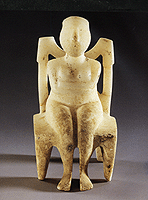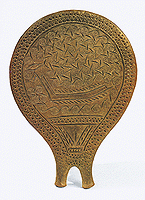Carpentry is particularly developed on the Aegean islands and serves the architecture, furniture manufacture and ship building. Information on these applications of carpentry, the perishable products of which did not leave traces in the course of time, is drawn from the stone tools (axes, drills) and copper or bronze tools (axes, chisels, drills, saws, nails), but also from the illustrations of buildings, furniture and ships in figurine manufacture, pottery and frescoes. Door and window frames and wooden shelves are used in architecture according to indications from the Late Cycladic town of Akrotiri while small tables, stools and chairs are already being manufactured from the Early Cycladic period in a great variety, visible on the marble figurines of seated women and musicians. Furniture of the late Cycladic period (stool and bed) were burnt to ashes at Akrotiri on Thera by the volcanic tephra leaving their signs which were preserved by the archaeologists in plaster. Ship building was of a particular importance for marine communication and the development of trade of the islanders. This art is considerably developed thanks to the combination of the technical expertise in carpentry with the experienced knowledge of hydrodynamics, aerodynamics and astronomy. Incised representations of ships on frying pans of the Early Cycladic II period and three lead boat models, 39,5 cm maximum length show that during the Early Bronze Age dug-out canoes which sail with 25-40 rowers were used. Such boats would be manned only with the alliance of several communities and could travel in a three-week period a distance of 200 nautical miles, transporting provisions, obsidian, metals, marble figurines and vases, etc. Sailing ships were not used until 2000 BC and are known from the fleet illustration preserved on the fresco of the "Miniature frieze" at Akrotiri on Thera.
|
 |
|
|
Naxos, cemetery of Aplomata. Marble figurine
of a seated female figure.
Early Cycladic II. |
||
 |
||
|
Syros, Chalandriani. Clay frying pan
with ship. Early Cycladic II. |
||